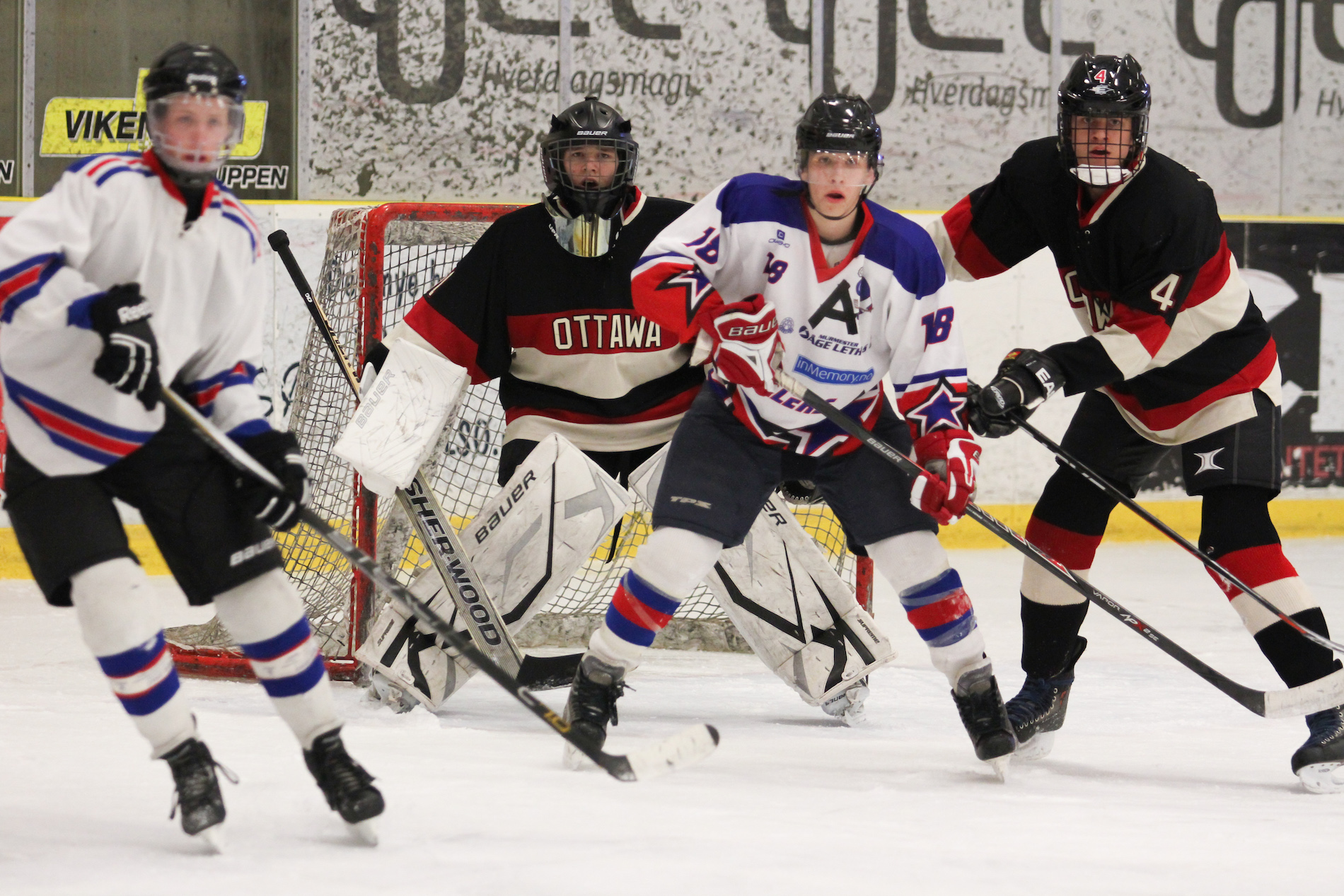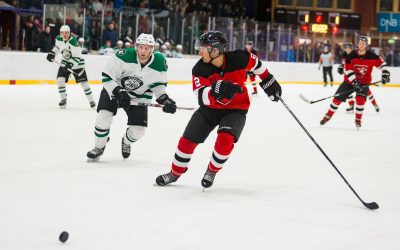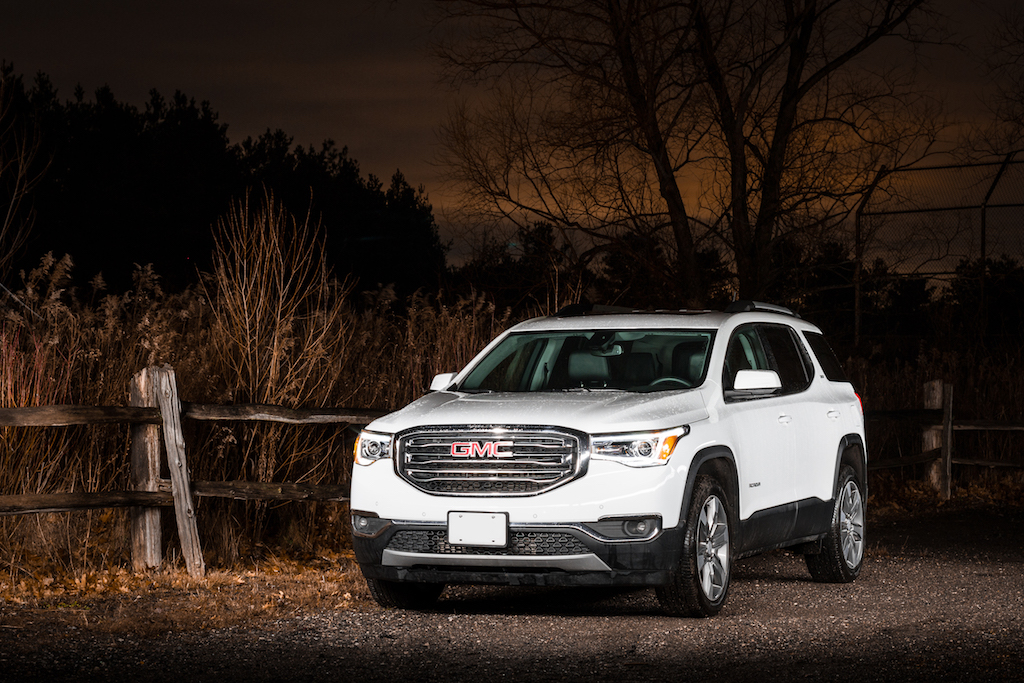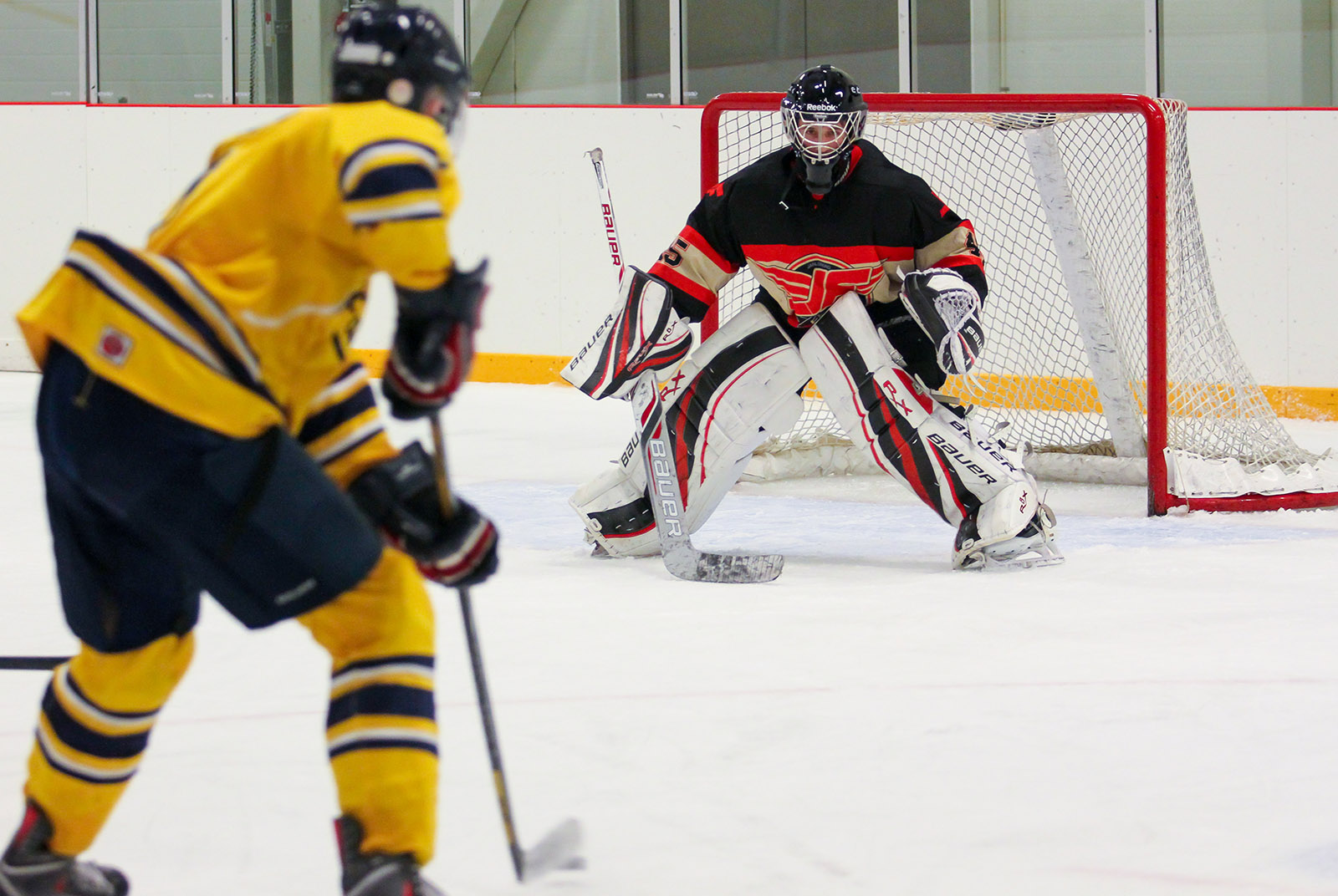Your Guide to Hitting Your Focus for Hockey Photography
Even if you have the greatest camera in the world and your settings are perfect, missing the focus will ruin your picture.

For this reason, being familiar with how focus works, as well as your camera’s focus modes and good techniques is incredibly important for maximizing the number of useable photos you come home with.
Understanding Focus
As discussed in a previous post, your selected aperture will influence the amount of distance in front and behind your focus point that stays acceptably sharp. If you have the available light or ISO performance to shoot with a narrow aperture, that will definitely help.
A camera locks its focus by measuring contrast. This means that trying to focus on surfaces with no contrast won’t get you very far.
For example, if you point your camera at a white section of the ice and your focus is likely to keep “hunting” without success.
Fortunately, colourful logos and player equipment often provides enough contrast to lock onto. You may find, however, that your camera’s focus tends to get distracted by the vibrant advertisements on the boards or the faces of spectators behind the glasses. Using a more precise focus mode can often help to resolve this problem.
Every image taken has only focus point. Even if your aperture is f16 and the whole image looks sharp, there is still only one point that the camera referenced for focus.
Knowing how focus works can help you hit a shot. If a player is skating towards you at full speed, you can’t focus, then wait a second and expect the player to still be in focus. On the other hand, the player is skating parallel to your focus, he could still be in focus a second later. This is because he remains the same distance away from the camera the whole time.
Whenever a play is coming towards one of the nets, a good trick is to focus in advance on the goalie. All the action funnels towards them so when the time comes, you’ll know that your focus is in the right place already.

Finding your ideal depth of focus
If you find yourself constantly missing your focus, a quick possible solution would be to set a narrower aperture. This will require a slower shutter speed or a higher ISO, but that is often preferable to a bunch of out of focus images.
I wouldn’t recommend going wider than f2.8 either, unless you are focusing on a fairly stationary target like the goaltender or players seated on the bench. Even the greatest photographer with the greatest camera is going to miss their focus if shooting a player moving at full speed with f1.8.
Focus modes
Knowing your focus modes can make a big difference. Canon and Nikon have different names for these focus types, but they do the same thing:
AI Servo / AF-C:
Servo focus should be your go-to focus mode for sports. In this setting, your focus will work continuously, making adjustments as your targets move. Since it doesn’t lock, this mode is perfect for the constant movement on the ice. Bear in mind that this mode will use more battery power, since it is constantly working. Servo focus may also catch some detail in the background and throw your shot out of focus, so you need to be very precise in tracking your subject.
One Shot / AF-S:
This focus mode will lock on a target, notifying you with a satisfying beep (or a red light, if you have turned the beep off). I’ve also heard that this focus mode tends to be a bit more accurate and uses less battery power, since it isn’t continuously hunting. One Shot focus is Ideal for stationary targets, but tends to be mostly useless for hockey action. Still, it’s a good option to keep in your back pocket for situations that require precision.
AI Focus / AF-S:
This last focus mode is a combination of the two previously mentioned modes.
Manual Focus:
Wonderful for portraits. Not for hockey.
Focus Points
Now that you have your focus modes figured out it’s time to explore the possibilities of focus points. Your camera comes with many focus points. You can use all of them, or as few as just one of them, depending on what best suits your situation.
Your camera may not have all the options I mention below, but odds are you’ll have some flexibility with your focus points that can help you make the shot.
All Focus Points:
Using all your focus points means you are leaving all the important decisions up to your camera. Your camera will measure the entire scene and select focus based on whatever has most contrast. Remember that your camera has no idea what it is looking at – it might grab focus on the spectators, the boards, players in the background, or, if you’re lucky, the player you want to focus on.
Single Point:
Using single point focus gives you a very precise target. The trick then becomes making sure you hit what you are aiming at. It’s easy to lose track of the play and suddenly focus on the background. When you’re anticipating and moving with the play, however, single point focus lets you hit shots that otherwise would be missed.
Expansion Point:
This focus mode focuses on a single point, but also considers nearby focus points. This is very helpful if you’re having trouble tracking the speed of the play with a single focus point.
Zone Focus:
If you’re having a terrible day and missing all your shots, zone focus is for you. This mode selects a region of focus point, gives you more precision than when you use all focus points, but leaving it wide enough that, at very least, you are going to hit something near to what you are aiming at.
Focus Techniques
Do you know what back button focus is?
If your answer is “no”, this next bit might be a game changer.
Most cameras are preset to have both focus and the shutter controlled by the same button: the shutter button. This is neat and convenient.
The drawback of having everyone controlled with the same button comes when you have to choose focus and composition independently … especially at the rapid pace of a hockey game. This is where back button focus is the king.
On most DSLRs, you should be able to use your camera menu to set a button on the top right corner of the back of your camera to control focus. This can be controlled with your thumb.
The shutter button can then be set to control only the exposure metering and release of the shutter.
By separating the actions of focusing and shooting into two different fingers, you get much more accurate control over each.
The best way to hit your focus at the rink is to practice, practice, practice. Using the various focus modes can help you out a lot, but tracking and anticipating the play while simultaneously nailing your focus is a skill that needs to be developed.
But with enough work, you’ll be shooting with pinpoint accuracy.
The latest posts from the Photography Blog
What are the benefits of commercial photography for your small business?
What are the benefits of commercial photography for your small business?How do you quickly grab a potential customer’s attention? People don’t read anymore and there are a million different distractions competing for interest, so anything mundane or expected...
What is the Best Lens for Ice Hockey Photography?
Welcome to the world of hockey photography! You’re up against low light and fast action. Without a little bit of planning, it’s the perfect recipe for blurry pictures.
You ready for a challenge?
I’m going to compile a list of some excellent lenses that you should think about getting if you want to take your hockey photography to the next level.
5 Tricks for Getting Great Natural Smiles for your Family Portraits
5 Tricks for Getting Great Natural Smiles for your Family Portraits One of the most important skills you can learn as a family photographer is how to coax natural smiles out of your subjects, whether they are young or old, during a photoshoot. Taking great...
Street Photography in Tulum, Mexico
Photography on the Streets of Tulum, MexicoI’ve always been drawn to candid photography. Sure, posed portraits are also fun to envision and create, but candid photography has always seemed like a more authentic expression of life. For me, photography is a way to...
Review of the MIOPS Smart Trigger and Mobile Remote
Review of the MIOPS Smart Trigger & Mobile Remote I recently got the chance to test some photography gear from MIOPS, a rather innovative company that produces triggers and remotes that can help inject some creativity into your photography. Now, I already had a...
Hockey Photography: Choosing Your ISO
Your Guide to using ISO for Hockey Photography Read more in the Hockey Photography Series: Introduction Aperture Shutter Speed ISO FocusWhat Lens to UseISO is an important piece in the puzzle to brings your final exposure together. Your knowledge of aperture and...







I like your Style! Keep going!